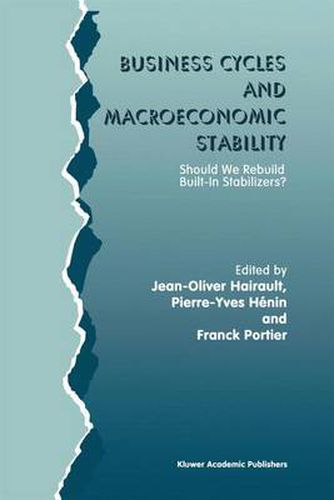Readings Newsletter
Become a Readings Member to make your shopping experience even easier.
Sign in or sign up for free!
You’re not far away from qualifying for FREE standard shipping within Australia
You’ve qualified for FREE standard shipping within Australia
The cart is loading…






This title is printed to order. This book may have been self-published. If so, we cannot guarantee the quality of the content. In the main most books will have gone through the editing process however some may not. We therefore suggest that you be aware of this before ordering this book. If in doubt check either the author or publisher’s details as we are unable to accept any returns unless they are faulty. Please contact us if you have any questions.
The future of built-in stabilizers is currently a matter of concern due to the various challenges arising from the processes of fiscal consolidation, international integration and the reflux from the welfare state. This text gathers relevant material for assessing the issue from both theoretical and empirical research. This volume describes the stabilization properties of fiscal policies on business cycles and growth within dynamic equilibrium models. It also gives attention to automatic stabilization within an economic union. Both the loss of control over monetary policy and the restraints on the use of fiscal policy for countries entering the EMU are sources of concern about the possibilities of stabilizing fluctuations affecting the members of the Union. Furthermore, attention is given to stabilization and labour market policies. The contribution of labor market institutions to automatic stabilizers is often advocated. Post World War II institutions have brought protection to employment, wages and unemployed substitution revenues which involve stabilization of actual income. Recent institutional changes towards more labor market flexibility, mainly motivated by efficiency purposes, may be costly in terms of stabilization. The final part is on empirical evidence, recent trends and problems in stabilization. It is devoted to empirical studies of the stabilization effect of alternative fiscal policies, emphasizing the experience of European countries in the 1990s.
$9.00 standard shipping within Australia
FREE standard shipping within Australia for orders over $100.00
Express & International shipping calculated at checkout
This title is printed to order. This book may have been self-published. If so, we cannot guarantee the quality of the content. In the main most books will have gone through the editing process however some may not. We therefore suggest that you be aware of this before ordering this book. If in doubt check either the author or publisher’s details as we are unable to accept any returns unless they are faulty. Please contact us if you have any questions.
The future of built-in stabilizers is currently a matter of concern due to the various challenges arising from the processes of fiscal consolidation, international integration and the reflux from the welfare state. This text gathers relevant material for assessing the issue from both theoretical and empirical research. This volume describes the stabilization properties of fiscal policies on business cycles and growth within dynamic equilibrium models. It also gives attention to automatic stabilization within an economic union. Both the loss of control over monetary policy and the restraints on the use of fiscal policy for countries entering the EMU are sources of concern about the possibilities of stabilizing fluctuations affecting the members of the Union. Furthermore, attention is given to stabilization and labour market policies. The contribution of labor market institutions to automatic stabilizers is often advocated. Post World War II institutions have brought protection to employment, wages and unemployed substitution revenues which involve stabilization of actual income. Recent institutional changes towards more labor market flexibility, mainly motivated by efficiency purposes, may be costly in terms of stabilization. The final part is on empirical evidence, recent trends and problems in stabilization. It is devoted to empirical studies of the stabilization effect of alternative fiscal policies, emphasizing the experience of European countries in the 1990s.